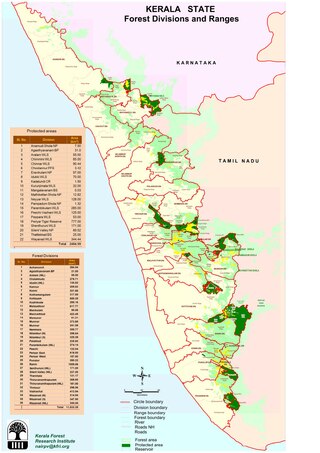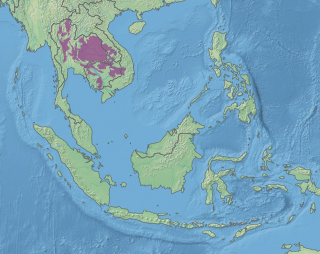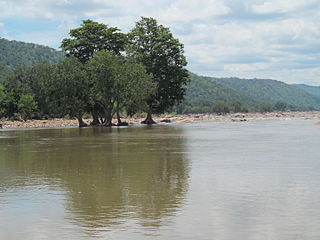
Ratanakiri is a province of northeast Cambodia. It borders the provinces of Mondulkiri to the south and Stung Treng to the west and the countries of Laos (Attapeu) and Vietnam to the north and east, respectively. The province extends from the mountains of the Annamite Range in the north, across a hilly plateau between the Tonlé San and Tonlé Srepok rivers, to tropical deciduous forests in the south. In recent years, logging and mining have scarred Ratanakiri's environment, long known for its beauty.

The Thamirabarani or Tamraparni or Porunai is a perennial river that originates from the Agastyarkoodam peak of Pothigai hills of the Western Ghats, above Papanasam in the Ambasamudram taluk. It flows through Tirunelveli and Thoothukudi districts of the Tamil Nadu state of southern India into the Gulf of Mannar. It was called the Tamraparni River in the pre-classical period, a name it lent to the island of Sri Lanka. The old Tamil name of the river is Porunai. From the source to sea, the river is about 128 kilometres (80 mi) long and is the only perennial river in Tamil Nadu. This river flows towards north direction initially. However, it changes to east direction later.

The forest snakehead is a species of snakehead, a fish of the family Channidae. Its range includes most of Southeast Asia and parts of southern China. It lives in forest streams and can reach 40 cm (16 in) in length. The forest snakehead is known in Thai language as pla krasong. Khmer language called it កញ្ជនជៃ, Indonesians named it kehung, while in Malaysia, they called it ikan bujuk in Malay Language and in Vietnamese its name is cá lóc dày

Most of Kerala's native habitat, which consists of wet evergreen rainforests at lower elevations and highland deciduous and semi-evergreen forests in the east, has a humid tropical climate. However, significant variations in terrain and elevation lead to high biodiversity. But Alappuzha district has no forests.

Barbonymus is a ray-finned fish genus in the family Cyprinidae, containing some barb species. The genus was only established in 1999, with the tinfoil barb as type species; thus, these fish are sometimes collectively called tinfoils. The new genus was established in recognition of the fact that some large Asian "barbs", formerly rather indiscriminately lumped in Barbus, Barbodes and Puntius, form a distinct evolutionary lineage.

The giant barb, Siamese Giant carp, or simply Siamese carp is the largest species of cyprinid in the world. These migratory fish are found only in the Mae Klong, Mekong, and Chao Phraya River basins in Indochina. Populations have declined drastically due to habitat loss and overfishing, and the giant barb is now considered critically endangered.

The wildlife of Cambodia is very diverse with at least 162 mammal species, 600 bird species, 176 reptile species, 900 freshwater fish species, 670 invertebrate species, and more than 3000 plant species. A single protected area, Keo Seima Wildlife Sanctuary, is known to support more than 950 total species, including 75 species that are listed as globally threatened on the IUCN Red List. An unknown amount of species remains to be described by science, especially the insect group of butterflies and moths, collectively known as lepidopterans.

The state of Karnataka in South India has a rich diversity of flora and fauna. It has a recorded forest area of 38,720 km2 which constitutes 55 of the geographical area of the state. These forests support 25% of the elephant population and 20% of the tiger population of India. Many regions of Karnataka are still unexplored and new species of flora and fauna are still found. The mountains of the Western Ghats in the western region of Karnataka are a biodiversity hotspot. Two sub-clusters of the Western Ghats, Talacauvery and Kudremukh, are on a tentative list of sites that could be designated as World Heritage Sites by UNESCO. The Bandipur and Nagarahole national parks which fall outside these subclusters were included in the Nilgiri biosphere reserve in 1986, a UNESCO designation. In the Biligiriranga Hills the Eastern Ghats meet the Western Ghats. The state bird and state animal of Karnataka are Indian roller and the Indian elephant. The state tree and state flower are sandalwood and lotus. Karnataka is home to 524 tigers.
Sarcocystis is a genus of parasitic Apicomplexan alveolates. Species in this genus infect reptiles, birds and mammals. The name is derived from Greek: sarkos = flesh and kystis = bladder.

The Java barb, more commonly known as silver barb in aquaculture, is a species of ray-finned fish in the genus Barbonymus.

The Central Indochina dry forests are a large tropical and subtropical dry broadleaf forests ecoregion in Southeast Asia.

Maduru Oya National Park is a national park of Sri Lanka, established under the Mahaweli development project and also acts as a catchment of the Maduru Oya Reservoir. The park was designated on 9 November 1983. Providing a sanctuary to wildlife, especially for elephants and protecting the immediate catchments of five reservoirs are the importance of the park. A community of Vedda people, the indigenous ethnic group of Sri Lanka lives within the park boundary in Henanigala. The park is situated 288 kilometres (179 mi) north-east of Colombo.

Khao Laem National Park is a park of about 1,500 square kilometers in Western Thailand, located near Myanmar in the northern area of the Tenasserim Hills, Kanchanaburi Province. It is a part of the Western Forest Complex, a system of protected wilderness in the Dawna-Tenasserim Hills area of western Thailand.

The Cauvery Wildlife Sanctuary is a protected area located in the Mandya, Chamarajanagar and Ramanagar districts of Karnataka, India. The Cauvery River passes through its midst. An area of 510.52 km2 (197.11 sq mi) was established as Cauvery Wildlife Sanctuary on 14 January 1987 under Section 18 of the Wildlife Protection Act 1972 with the objective of providing protection, conservation and development of Wildlife and its environment. The sanctuary was expanded to its current area of 102,753 hectares in 2013. On its east, it adjoins Dharmapuri forest division of Tamil Nadu state.












